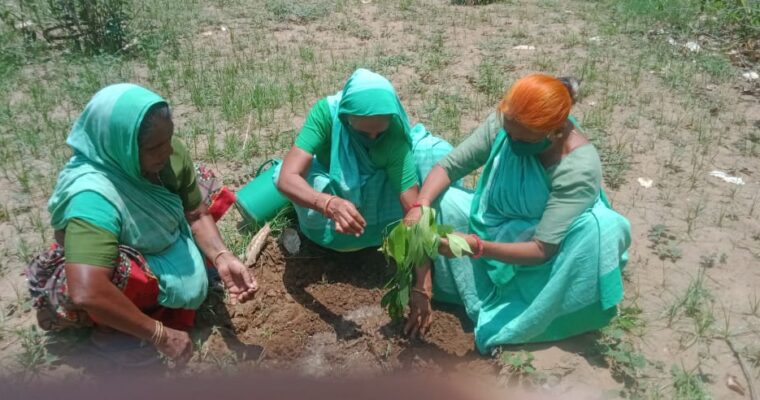This article is originally posted by FAO
Smallholder farmers gain greater recognition in 2022 and unify their voice.
Significant steps have been taken in 2022 to raise the visibility of forest and farm producer organizations (FFPOs) and gain greater recognition of their important role in reversing climate change, biodiversity loss, and stamping out persistent rural poverty and inequality.
FFPOs are grassroots-led self-organized entities, including farmers unions, cooperatives, Indigenous Peoples Organizations, producers and agroforestry groups, with a formal or informal structure. They represent 1.5 billion smallholder producers, generating products from multiple smallholdings, that mix biodiverse agriculture, agroforestry and natural forests. Pursuing diverse markets, they frequently also fulfill wider sustainability, resilience and equity goals.
But their key role in safeguarding forests has not yet garnered sufficient recognition.
“Indigenous People’s organizations have created stronger visibility of their role as key guardians of the forests in the past 5 years and they are increasingly being considered for direct access to climate finance, but it is a different situation for the farmers organizations,” IUCN Senior Programme Officer Pauline Buffle says. “We are seeing some changes now though. Donors and foundations are increasingly understanding the importance of their role. That being said, there is still a lot to do for both Indigenous Peoples Organizations and Farmers organizations to ensure they are considered and financed as they should be.”
This year, more than ever, representatives of grassroots organizations have advocated about the key role that they can play, to bring international environmental and development finance to farmers, Indigenous Peoples and local communities.
During 2022, representatives of smallholder farmers’ organizations led a campaign ahead of COP27, supported by the Forest and Farm Facility (FFF), on the theme of getting climate finance to the ground. They took part in in more than 20 events and dialogues with donors, global climate funds and government officials. In the process, they also worked on building a media presence for the previously overlooked sector.
Raising visibility
As little as 1.7% of global climate finance reaches these groups who manage half of the world’s land and often manage it more sustainably than larger concerns. Their marginalization in funding decisions can be due to donors’ concerns of the risks that these communities are not ready to receive large amounts of funding and higher transaction costs, or simply that there is no priority set for some funds to reach the ground.
A significant element of the campaign to increase the visibility of smallholders and understanding by donors has included shining a light on territorial financing mechanisms already developed by the farmers organizations, indigenous peoples and local community groups.
Two landmark meetings aimed at advancing these as alternatives to the current aid model. The first in Mexico on 7 to 9 October 2022 organized by the Mesoamerican Alliance of People and Forests involved indigenous people’s groups from Mesoamerica, Amazonia, Brazil, and a few farmers organizations representatives from Africa and Asia.
Farmers and indigenous representatives compared notes on designing and implementing the territorial financing mechanisms, identifying common problems and exploring possibilities for cooperation. They called for the creation of a Community Territorial Finance Alliance aimed at transforming financing mechanisms from the grassroots.
That was followed by a meeting in Washington D.C. on October 12 to 13 2022 with potential donors and allies interested in investing in and strengthening the capacities and processes of these mechanisms. The audience learnt that they target the real needs of communities, are inclusive and collaborative, efficient, reliable, safe, scalable, and impactful.
Participants called for a transformation of funding relationships:
‘‘Communities are investing, not necessarily only monetarily but also in terms of time and knowledge, among other aspects, to contribute to the fight against climate change, biodiversity conservation and reversing the degradation of nature and it is probably a larger investment than governments and other actors,” Gustavo Sanchez, President of the Mexican Network of Forest Peasant Organizations said. “We call on the international community to overcome the vision of ‘donors and beneficiaries’ and to adopt a vision of ‘co-investors and allies’ in more horizontal and equitable relationships.’’
FFF also provided support to the Shandia platform, a new global mechanism using a wide range of channels and pathways to ensure finance reaches communities, with an emphasis on supporting existing territorial funding mechanisms. The Shandia platform will identify funding opportunities and negotiate agreements for medium and large projects.
“We need to change the narrative around risk,” International Institute for Environment and Development (IIED) Senior Research Scientist Duncan Macqueen said. “Smallholder farmers and producers have proven to be a trustworthy investment for the COVID responses. What is too risky is not to involve those who change what happens on the land.”
Creating a new common narrative between smallholders
The issue of an open letter to world leaders ahead of COP27 helped with creating global understanding by articulating a strong unified public message on behalf of small-scale family farmers and producers.
“At a time of rising food insecurity, it is crucial that COP27 decision makers recognize the important role we play in feeding the world and significantly increase the amount of adaptation finance available to us now and in the long term,” one paragraph of the letter stated.
The letter reportedly strengthened a feeling of empowerment in the forest and smallholder farmer groups.
Looking ahead
While some forest and smallholder farmer groups, are very close to being able to develop their own funds, others need more support to have the internal capacity to do so. The FFF (a partnership between FAO, IUCN, IIED and AgriCord) continues to assist in the work to build their structures, capacity, governance, and accountability to donors.
It is also organizing and supporting more opportunities for exchanges aiming to attract larger amounts of international finance and direct it to the ground. The next global exchange will take place in Brazil and will be host by the Coordination of the Indigenous Organizations of the Brazilian Amazon (COIAB).
This article is originally posted by FAO
Related links




Comments are closed